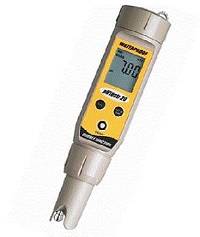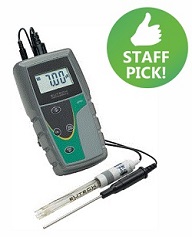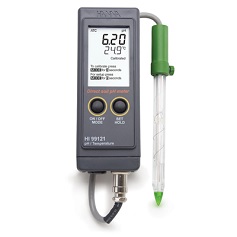The most effective methods for undertaking soil pH measurements?
The most effective methods for undertaking soil pH measurements? |
How do different soil pH methods change the pH results you obtain?Would you assume all methods of undertaking pH measurements within soil produce the same results? Read this month's experiment below to find out if they do What is the most accurate way of measuring pH and which method should you use?This month we are going to cover the varying methods of undertaking soil pH measurements and the most effective way of going about it. We will cover a variety of methods and why certain methods produce more repeatable results that replicate natural conditions. | |||||||||||||||||||||||||||||||||||||||||||||||||||||||||||||
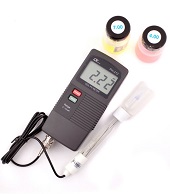 Can the method you use determine the accuracy of your pH results in various soil types?Soil pH is a measure of the acidity or the alkalinity of soil. It is important for gardeners and farmers as it can affect nutrient availability, alter the risk from pests and diseases, and generally affect plant growth. There are a number of ways of measuring soil pH and in this month’s experiment we will be comparing 3 different methods on 2 different soil types as well as a compost to determine whether the results from each method are comparable. | |||||||||||||||||||||||||||||||||||||||||||||||||||||||||||||
Equipment
Method For the experiment a large bucketful of clay soil, a commercial bag of compost, and sandy loam soil from the Instrument Choice garden were used. Each soil sample was visually assessed for organic matter and stones and, if found, were removed. Each sample was then measured using each of the three pH meters as per the following tests. To check consistency, each test was repeated 3 times: ICZD06 – Analogue direct soil pH test 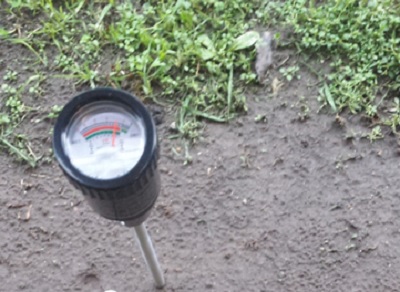 For this test the ICZD06 was inserted directly into moist soil until a stable reading was attained as per the manufacturer’s instructions (about 10 minutes). If the soil was not moist enough, distilled water was added until the soil was moist enough to give a reading. The reading was then read off the analogue dial. For the sandy loam soil tests, this was done in-situ out the front of our 22A Cavan Road store, the clay tests were measured in the bucket, and the compost was measured directly in the bag. PH212 – Digital direct soil pH test 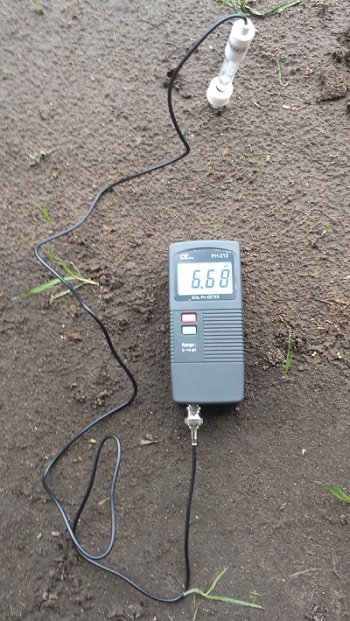 For this test the soil sample was prepared as for the ICZD06. The spear tipped electrode was then carefully inserted into the soil ensuring good contact with the soil. The pH of the soil was then read off the digital display once it had stabilised which typically took 5-20 seconds. Prior to each test the unit was calibrated with pH4 and pH7 buffer solutions to ensure accuracy. EC-PHtestr30 – Digital 1:5 soil water mix pH test For this test, 20 grams of dry soil was measured on the Ohaus SCCL501 digital scales, it was then mixed and shaken with 100mL of distilled water in a clean dry jar with the aim of dissolving all of the salts within the soil. The soil-water mix was then left to settle for 10 minutes and a reading was taken of the water with the EC-PHtestr30. The reading was taken off the digital display once it had stabilised. Prior to each test the unit was calibrated with pH4 and pH7 buffer solutions to ensure accuracy. 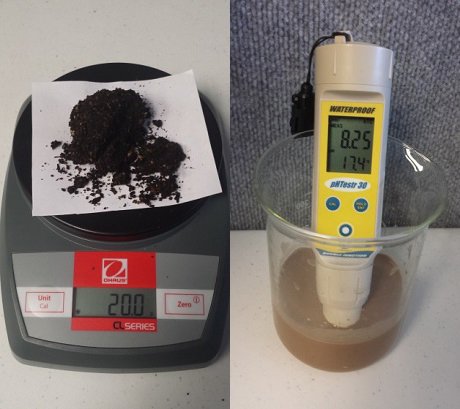 All of the results from each test were recorded in tabular form and the three readings for each soil type and test were averaged. Results
Table 1: This table shows the pH levels of sandy loam as tested with the three different methods
Table 2: This table shows the pH levels of clay as tested with the three different methods
Table 3: This table shows the pH levels of compost as tested with the three different methods 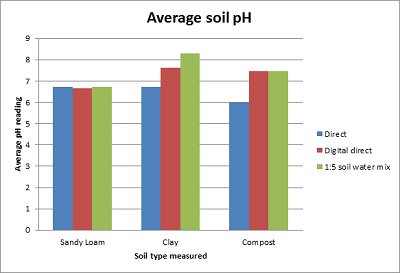 Figure 1. Average pH readings for each soil sample as measured by the direct, digital direct and 1:5 soil-water mix methods Discussion and Conclusion The three different methods of pH testing gave very comparable results when testing in the sandyloam soil with the average readings for each method within 0.07pH of each other. There was also very little variation from test to test using the same meter. For sandy-loam soils all measuring methods appear to give accurate and repeatable results. The tests performed on the clay soil were the most variable and there was a large variation between the direct, digital direct and the 1:5 soil water methods. The two digital methods gave the closest readings (within 0.7pH of each other) whereas the ICZD06 was reading low by 0.88-1.56pH. We discussed this with the manufacturer of the ICZD06 unit and they stated that their unit works by harnessing the small current produced by 2 dissimilar metals. They said that as a result of this, in saline alkaline soils, the soluble salts can interfere and give erroneous readings. Clay soils are typically alkaline, so if you have this soil type in your backyard, then using a digital pH meter is going to give you the best results. The results from the test on compost showed that the digital meters gave very comparable and repeatable readings and that the non-digital unit was not as accurate. Again, the ICZD06 is known to struggle in soil preparations with high fertiliser content, and the compost mix we tested did have added fertiliser. The results from this experiment have shown that digital pH meters give the most consistent soil pH values across the range of soil types, and, for applications where high accuracy is needed, a digital pH meter would be the recommended option. For home use where the highest levels of accuracy may not be critical then the ICZD06 would be a suitable option, although the end user should ensure that the soil they are testing is not saline alkaline soil or soil to which fertiliser has recently been added. | |||||||||||||||||||||||||||||||||||||||||||||||||||||||||||||
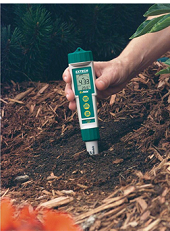 Understanding the best method for measuring soil pH!The pH of soil is an important measurement to assess the viability of plant growth within a certain environment. Soil is made up of a range of components this includes mineral particles such as sand, silt, clay or loam (which gives soil its texture), organic matter (whether it be living dead), along with air and water and this determines it properties. The water contained within the soil is where the pH changes. This is because this is where the dissolved chemicals cause the soil to be basic or acidic. The pH of a soil is determined by the concentration of Hydrogen ions in the water contained within the soil. This is due to Hydrogen Ions being an acid Cation, therefore the greater the concentration of Hydrogen Ions within the water the lower the pH (more acidic); conversely the lower the concentration of Hydrogen Ions the higher the pH (more basic). The pH of a particular soil will change over time and is influenced by a range of factors. These include the parent material, weathering of the material along with the practices the soil is used for (such as crops, livestock etc.). It will also fluctuate through the year due to things such as increased rainfall or drought. So, how does one go about undertaking effective pH measurements to produce accurate and repeatable results? There are three methods which can be used to undertake these measurements. These include a Soil in Calcium Chloride test, a Soil in distilled water test along with a direct test. These methods are explained below: Soil pH in Calcium Chloride:An air-dry soil sample is mixed with five times its weight of a dilute 0.01M Calcium Chloride (CaCl2) solution, it then needs to be shaken and left to stand for approximately 10 minutes. From here the measurements are taken using a pH meter and suitable electrode by inserting the electrode into the solutions and the results expressed as pH (CaCl2). Soil pH in distilled water:This test is performed in the same method as the “Soil pH in Calcium Chloride” method; however the dilute 0.01M Calcium Chloride (CaCl2) solution is replaced with distilled water. These measurements then need to be expressed as pH (w) specifying water has been used. The most popular meters for undertaking the “Soil in Calcium Chloride” and the “Soil in distilled water” methods are shown below:
This test is pd by digging 5cm into the soil profile and then discarding the first 5cm of topsoil. The soil then needs to be loosened and any stones removed. If the soil is dry it will need to be wetted down with a small amount of distilled water. The soil can then be tested by inserting the electrode into the soil (if a spear tip electrode is used) or by applying the electrode to the surface (if a flat surface electrode is used) making sure proper contact is made. The most popular meters for undertaking “Direct testing” are shown below:
PH100 HI99121 The most repeatable method from the options detailed above is the “Soil pH in Calcium Chloride” method. This is because when the soil is wetted with distilled water the Hydrogen Ions tend not to be released into the soil solution and are more attracted to the soil particles resulting in a higher pH value than the natural soil solution. When a dilute CaCl2 solution is used, the Calcium ions replace some of the Hydrogen Ions on the soil particles. This therefore forces some of the Hydrogen Ions into the soil solution and more closely replicates conditions that would be found in the field. As an approximate using a CaCl2 will produce a result that is 0.8pH lower than when distilled water is used, however this can increase to as much as 2.0pH with certain soils. T This is shown below: 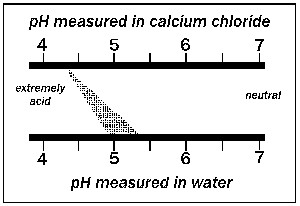 Figure 1: pH measured in Calcium Chloride solution compared with distilled water If you are unable to perform your test using a CaCl2 solution and need to use either the “direct testing” or the “soil in distilled water” method then ensure all of your tests are conducted using the same method as this will assist in producing comparable results. If you need any assistance with selecting the right meter to undertake soil pH measurements or have any questions regarding the information above please feel free to email one of our friendly Scientists or give us a call on 1300 737 871. | |||||||||||||||||||||||||||||||||||||||||||||||||||||||||||||

